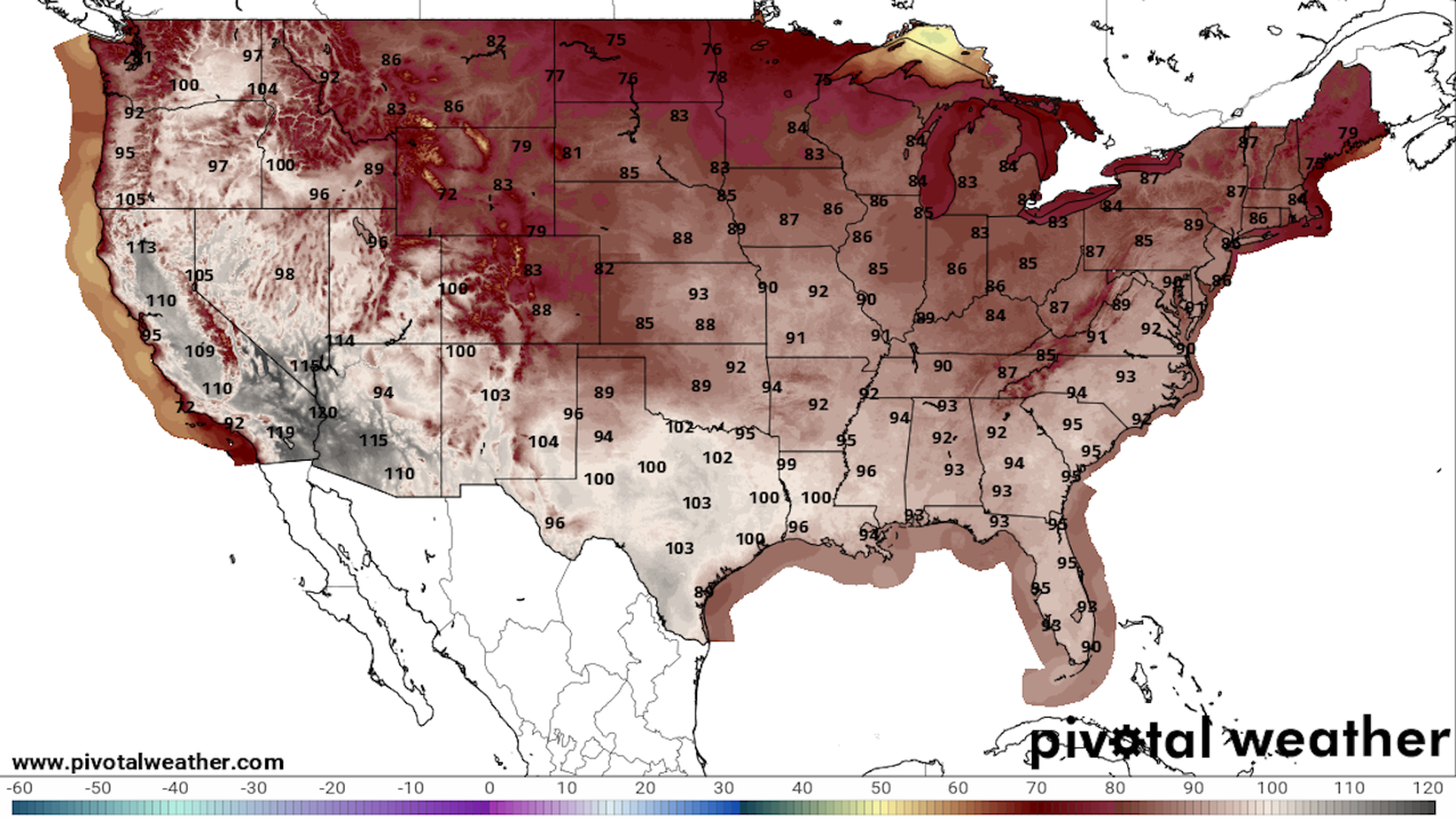Almost a third of the U.S. population was sweltering under an intense heat wave Wednesday, with the National Weather Service issuing heat alerts covering 100 million people, Reuters reports. The Southwest is under particular stress, with Phoenix on its 13th straight day of highs above 110 degrees Fahrenheit. Other states dealing with soaring temperatures include California, Texas and Florida. The latter is recording water temperatures of over 90 degreesin the Gulf of Mexico, posing a threat to coral reefs. Forecasters say widespread relief is unlikely until next week.
- Extreme heat tops the list of weather-related killers, the NWS says. However, deaths often remain unreported until after temperatures fall, making heat “a quiet killer” compared with other natural disasters, Axios notes.
By Saundra Latham, Editor at LinkedIn News
Expanding heat wave leaves more than 112 million under alerts

An expanding, intensifying heat wave prompted the National Weather Service to issue heat alerts for more than 112 million people on Tuesday evening, with no letup in sight for some areas.
Why it matters: The heat will topple longstanding records, especially in the Southwest, and the long duration of this event, continuing well into next week in some areas, increases public health dangers.
The big picture: This heat wave is already notable for its scope, intensity and endurance, as an area of high pressure aloft, also known as a heat dome, will become centered over the Southwest but maintain an influence from the Southeast to the South-Central states and into the Great Basin and California.
- The Southwest will see the longest-lasting impacts, and parts of Texas are coming off their hottest June on record.
- “Unfortunately, the long term outlook for the region shows a continued heatwave through this weekend and into next week,” the NWS stated about the Southwest in an online forecast discussion.
- Alerts are up from Florida to California, and include nearly the entirety of Texas and Oklahoma.
Zoom in: Cities in the Southwest that are synonymous with heat are poised to break daily, monthly and potentially even all-time high temperature records during this event, as well as set milestones for the longest streak of exceptionally hot days.
- For example, Phoenix is on track to either tie or break its record of 18-straight days with highs of 110°F or above, having had their 12th such day in a row on Tuesday.
Threat level: Phoenix even has a chance of seeing temperatures climb to 120°F this weekend. If this occurs, it would only be the fourth time since reliable records began there in the 1920s, and perilously close to the city’s all-time record of 122°F.
- “Widespread areas of Major Heat Risk will increase to Extreme levels this weekend,” the NWS forecast office in Phoenix stated.
- Las Vegas may see its hottest temperature on record of 117°F be challenged. Death Valley, Calif., one of the hottest spots on Earth, is predicted to see temperatures climb into the rare territory of between 129 and 130°F this weekend. If it exceeds 130°F, this would be a new global all-time high temperature record
- The heat dome itself may peak at record intensity for the Southwest at this time of year, indicating a highly unusual weather pattern.

- Florida is seeing extremely high heat indices, in part because Gulf of Mexico water temperatures are hot tub-like, in the 90s, which is unheard of for this time of year.
Meanwhile, several wildfires erupted across Southern California this week ahead of expected triple-digit temperatures arriving Thursday.
- Firefighters are battling two large fires in the state, according to the National Interagency Fire Center. There are also eight large fires in Arizona, four in New Mexico, three in Oregon and two in Colorado, per the NIFC.
Of note: Extreme heat is the top weather-related killer during an average year in the U.S., per the NWS.
- Heat waves can be extremely deadly, particularly when elevated temperatures are persistent and there is a lack of significant cooling at night. Overnight lows in Phoenix and Las Vegas, for example, may not go below 90°F for several nights in a row.
- Unlike hurricanes and tornadoes, heat waves are a quiet killer, with deaths often going un-tallied until well after the extreme weather event has subsided.
- For example, a study published Monday, found that European heat waves killed 61,000 people last year, in a demonstration of how inadequately prepared many countries and cities are for climate change-driven temperature spikes.
Context: A new analysis, using peer-reviewed methods, from Climate Central shows that climate change is likely boosting the odds for the upcoming extreme heat in Arizona by at least a factor of four.
- Many studies show that heat waves are more likely, longer lasting and more intense as global average surface temperatures increase. The main cause of long-term climate change is human-caused emissions of greenhouse gases such as carbon dioxide, due to burning fossil fuels such as coal and natural gas.
- In fact, some research has shown that without climate change, certain heat waves would have been virtually impossible to occur.
Yes, but: Right now, a gathering El Niño event in the tropical Pacific Ocean is beginning to add even more heat to the global climate, exacerbating a seemingly nonstop series of climate disasters.
Editor’s note: This article has been updated with new details on wildfires, weather alerts and further context.
BY Andrew Freedman, author of Axios Generate










